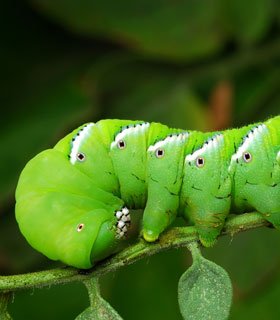
Let’s dive into the fascinating world of hornworms and explore what leads to their population spikes. Whether you’re a seasoned gardener or just trying to keep your houseplants alive, understanding these critters can help you manage their impact effectively. It’s like having a backstage pass to a concert—once you know how things work, you can enjoy the show much more!
What Are Hornworms?
Before we dig into the population spikes, let’s first clarify what hornworms are. These caterpillars belong to the family Sphingidae and primarily include species like the tomato hornworm (Manduca quinquemaculata) and the tobacco hornworm (Manduca sexta). They’re often green, with distinctive markings that can make them blend in seamlessly with leaves. This camouflage is one of their survival tactics.
Hornworms are the larval stage of large moths. They start life as eggs laid on the underside of leaves, then hatch and start eating voraciously. If you’ve ever seen one, you know how quickly they can munch their way through a plant. It’s a bit like watching a toddler devour a cookie—once they start, there’s no stopping them until it’s all gone!
Factors That Influence Population Spikes
You might wonder what causes hornworm populations to explode. Several factors come into play, and understanding them can help gardeners prepare. Let’s break it down:
Climate Conditions
Climate is a big player when it comes to hornworm populations. Warmth and humidity provide the perfect conditions for hornworms to thrive. They prefer temperatures between 75°F and 100°F. When spring and summer roll around, these caterpillars take advantage of the sunny days to grow and breed.
Rainfall also affects their growth. A little rain can be good—it helps plants grow, which means more food for hornworms. However, if it rains too much, it can drown them or wash away their eggs. It’s like finding the right balance in a recipe; too much or too little can throw everything off.
Availability of Host Plants
Hornworms are picky eaters but can munch on several plants. They’re particularly fond of tomatoes, pepper plants, and eggplants. When these plants flourish, hornworm populations can skyrocket. If you have a garden full of their favorite snacks, it’s a buffet for them!
Here’s the thing: when host plants are healthy and plentiful, it becomes easier for hornworms to lay their eggs. It’s like having a big family dinner where everyone brings a dish to share—more food means more mouths to feed. If your garden is full of their favorites, look out!
Life Cycle of Hornworms
Understanding their life cycle can help you predict when you’ll see more of these pests. Hornworms undergo complete metamorphosis, which means they have four distinct stages: egg, larva, pupa, and adult moth.
– **Eggs**: Females lay eggs on the underside of leaves.
– **Larva**: Once they hatch, the hornworms go on a feeding frenzy. This is the stage most gardeners notice.
– **Pupa**: After growing, they drop to the ground and form a pupa, where they undergo transformation.
– **Adult Moth**: Finally, they emerge as moths, ready to reproduce and continue the cycle.
The rapid growth in the larval stage is what leads to population spikes, especially during warm, moist conditions. It’s like hitting the fast-forward button on their lives!
Predators and Natural Controls
Interestingly, hornworms aren’t invincible. They have natural enemies, like parasitic wasps and birds. These predators can help keep their numbers in check.
– **Parasitic Wasps**: They lay eggs inside hornworms, and when the larvae hatch, they eat the hornworm from the inside out. It might sound gruesome, but it’s nature’s way of balancing the ecosystem.
– **Birds**: Many birds enjoy a meal of hornworm. If you notice birds flocking to your garden, it’s a good sign!
Keeping this in mind, sometimes a healthy ecosystem can help manage hornworm populations naturally. Encouraging birds and beneficial insects in your garden can be a great strategy.
How to Manage Hornworm Infestations
So, if you find yourself with a hornworm problem, what can you do? Here are some tips to manage infestations:
- Manual Removal: Check your plants regularly and simply pick off any visible hornworms.
- Natural Predators: As mentioned, attracting birds or introducing beneficial insects can help.
- Insecticidal Soap: This can deter hornworms without harming beneficial insects.
- Crop Rotation: Change where you plant your tomatoes and peppers each year to disrupt their lifecycle.
Honestly, a little prevention goes a long way. Regular checks can help catch a few hornworms before they become a larger problem.
Hornworm population spikes can be surprising, but understanding their behaviors and life cycles can help you stay one step ahead. By knowing what attracts them and how to manage their presence, you can protect your plants and enjoy a bountiful harvest.
Remember, a healthy garden is a balanced ecosystem. Whether you choose manual removal or attract natural predators, being proactive will make all the difference. So, next time you notice those pesky hornworms, you’ll be equipped with the knowledge to tackle the issue head-on. Happy gardening!
